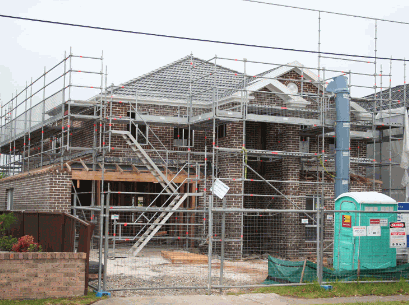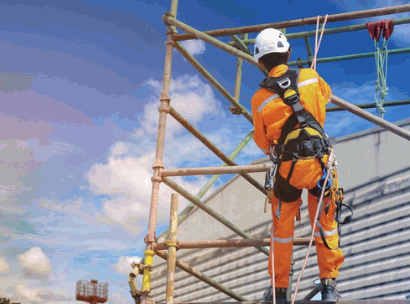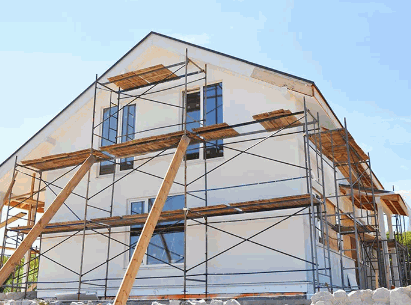Scaffolding is an essential component of many construction and renovation projects, providing workers with safe and stable access to elevated areas. It ensures that tasks at height are carried out efficiently and securely.
However, we're often asked, "How long can scaffolding be left up?" This is a crucial consideration for both safety and project planning, as leaving scaffolding up for extended periods requires careful monitoring and maintenance to prevent any hazards.
In this Scaffold Crew blog, we'll explore the factors that determine the duration scaffolding can remain erected and the relevant safety regulations in the UK to ensure compliance and worker safety.

While it's in everyone's best interests to dismantle scaffolding structures as soon as possible, sometimes they have to remain in place for longer - sometimes indefinitely.
We're going to explore these reasons to find out how long scaffolding can be left up, and what the implications might be.
The most straightforward factor affecting how long scaffolding can be left up is the length of the project itself. Scaffolding can remain in place as long as it is necessary, whether it is a few days for minor repairs or several months for major construction work. For shorter projects, such as quick maintenance or minor repairs, scaffolding might only be required for a brief period. However, for extensive construction or renovation projects, scaffolding may need to remain erected for several months or even longer.
The key consideration is to ensure that the scaffolding remains safe and stable throughout its use, regardless of the project duration. This involves planning for regular inspections and maintenance to address any wear and tear that may occur over time. Additionally, factors such as the complexity of the work, the stages of construction, and the need for continuous access to various parts of the building will influence how long scaffolding is required. By aligning the scaffolding schedule with the overall project timeline, project managers can ensure that the scaffolding is available when needed and dismantled promptly once it is no longer required, minimising unnecessary risks and costs.
Scaffolding must remain safe and stable throughout its use, which is crucial for protecting workers and ensuring the success of the project. This involves regular inspections and maintenance to ensure it continues to meet safety standards. Regular checks are necessary to identify any signs of deterioration in the materials, such as rust, corrosion, or wear and tear, which can compromise the scaffolding’s integrity. Additionally, environmental factors, such as extreme weather conditions, can impact the stability of the scaffolding structure, making it essential to monitor for any damage caused by strong winds, heavy rain, or snow.
Maintaining the structural integrity of the scaffolding is also paramount. This includes ensuring that all connections and joints are secure, platforms are stable, and that there are no signs of weakness in the framework. Any issues identified during inspections must be promptly addressed to prevent accidents and ensure the scaffolding remains a safe working platform. By rigorously monitoring these factors, project managers can guarantee that scaffolding remains a reliable and secure structure for the duration of its use, safeguarding both workers and the project itself.
It's important to note here that not anyone can construct scaffolding! Only licenced, trained, and registered scaffolding companies are allowed to erect scaffolding structures and dismantle them when the construction project is ended. Also, you'll need permission from your local council if you need to erect scaffolding on or by a public highway.
So far, this is basic common sense. But now we need to check to see what the actual rules and regulations say!

The UK has specific safety regulations governing the use of scaffolding. Compliance with these regulations is mandatory and impacts how long scaffolding can be left up.
The Health and Safety Executive (HSE) provides clear guidelines on the erection, use, and dismantling of scaffolding.
Key points include:
Dig Deeper: How Often Does Scaffolding Need To Be Inspected

For scaffolding to remain safe over extended periods (i.e. more than two weeks), the following practical considerations should be taken into account:
Ongoing maintenance by the scaffolding contractor is essential to address wear and tear, particularly in long-term projects. This includes tightening any loose fittings, replacing damaged components, and ensuring that safety features such as guardrails remain intact. Regularly scheduled inspections should be conducted to identify any potential issues early, allowing for prompt repairs or adjustments to be made. Proper lubrication of moving parts and checking the stability of the base supports are also important aspects of maintenance.
Implementing measures to protect scaffolding from adverse weather can prolong its lifespan. This might include using weather-resistant materials or coverings. Ensuring that scaffolding is designed to withstand environmental conditions such as high winds, heavy rain, or snow loads is crucial. Using protective sheeting or tarps can help shield the structure from weather-related damage, while also providing some protection to workers from the elements.
Ensuring that scaffolding is secure from unauthorised access can prevent vandalism or misuse, which can compromise safety. This might involve installing barriers or fencing around the construction site and scaffolding and using locks or security systems to restrict access to authorised personnel only. Clear signage should be posted to warn of the dangers of tampering with the scaffolding. Additionally, regular patrols or surveillance of the site can help deter unauthorised access and ensure that the scaffolding remains secure at all times, particularly if there are hazardous materials on site.

While it's vitally important that all safety regulations are followed, you can't rule out accidents 100%, unfortunately. And the longer scaffolding is in place, the higher the risk of an incident. All construction projects should have public liability insurance cover throughout the duration of the work to provide peace of mind in the event of any accidents or damage.
By taking these practical considerations into account, scaffolding can remain safe and stable for extended periods, ensuring that it continues to provide a reliable platform for workers and contributing to the overall safety and success of the project.
Is your scaffolding going to encroach on a neighbour's property? Will the general public be affected? Will the structure be easily accessible, or is the area narrow and restricted?
What about the age of the building - is it a period property or a listed building located in a conservation area?
All of these factors need to be considered as they could affect the amount of time scaffolding is allowed to be left in place! At the end of the day, it's your responsibility to ensure that scaffolding is erected safely and responsibly.
This is especially so if it has to be in place for an extended period.
Check out: Can A Neighbour Refuse Access For Scaffolding

The first question to ask is whether you actually need scaffolding as part of your project requirements. For example, if you're cleaning a gutter or replacing a roof tile, you could get away with using a secured ladder - as long as you follow all the safety precautions!
For more involved projects, always use a reputable building company and listen to their advice. They will always ensure safety procedures are followed and will use a scaffolding hire company (very few contractors keep their own scaffolding!).
The cost of hiring scaffolding will usually be included in the final bill, so it's important to acknowledge this if the structure is left in place for long periods.
Learn more: How Much Is Scaffolding For A House

In summary, scaffolding can be left up for the duration necessary to complete the project, provided it remains safe and compliant with UK regulations. Regular inspections, maintenance, and adherence to HSE guidelines are critical to ensuring that scaffolding remains a secure and stable platform for workers. By following these practices, we can ensure that their scaffolding solutions meet the highest standards of safety and reliability throughout their use.
To begin with, the installation process must be carried out by a professional scaffolding company.
Remember - scaffolding is designed to be a temporary structure! There are times when it has to be left in place much longer than anticipated, but it should always be removed as soon as the maintenance, cleaning, or building work has finished.
For any scaffolding needs or further advice on safety regulations, contact the Scaffold Crew. Our team of experts is dedicated to providing safe and efficient scaffolding solutions tailored to your specific project requirements.




